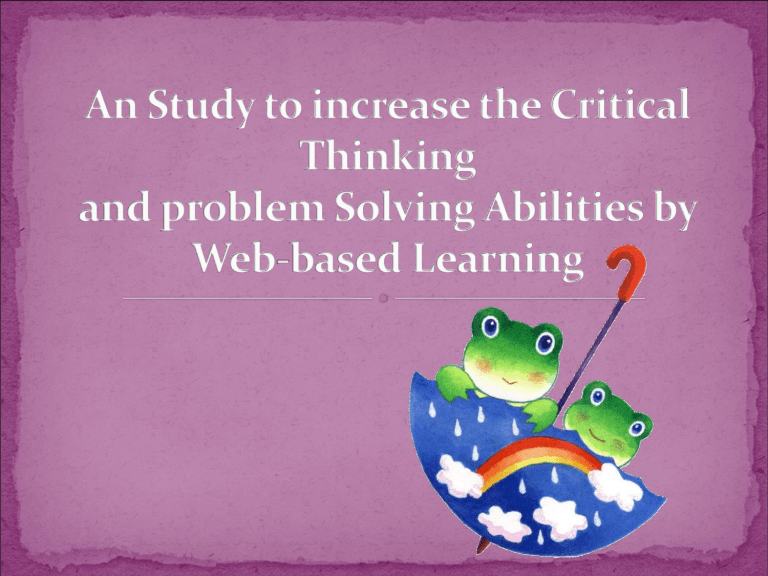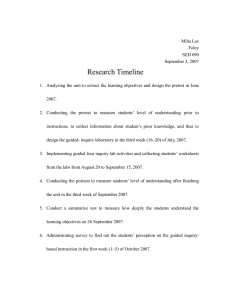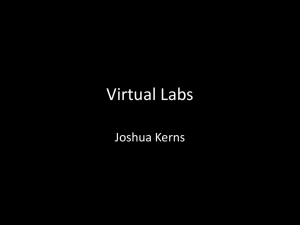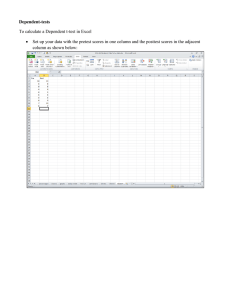Document 15982196

RONG-JYUE FANG
CHIEN-CHUNG LIN
HUNG -JEN YANG
HUA- LIN TSAI
CHI -JEN LEE
TIEN-SHENG TSAI
Motivation and
Purpose
Literature Review
Methodology
Results and Discussion
Conclusion
It’s an important development trend of today’s educational technology to integrate information into instruction.
Owing to the fast improvement of www, communication technology, computer technology and software and technology, it can be foreseen that information technology must be the initial element of present education and instruction .
From Hambermas's theory of democracy, there are two priorities reaching a consensus by debate. First, those who attend the debate must be reasonable enough to communicate and judge the reality, legitimacy, and sincerity. Second, “an ideal talking situation”
This mold of discovery and participation allows students to be the master of learning, encourages them to develop the thinking ability, creativity, and builds up their values and worldview.
(1). Meaning and features of critical thinking instruction :
Critical thinking is a high level of cognitive ability.
According to Ennis, critical thinking is to “decide what to be believed or to be the focused reflective and reasonable thinking.”In view of problem-solving, critical thinking is an intellectual activity of choosing proper hypotheses or answers
Decision of belief and action
Clearing the intention of critical thinking
Inference
Foundation laying, information:
From others, from observation, accepted conclusions
( mentioned ) , knowledge from experience, educational background and surroundings
Problem-solving
Interaction with external world and others
Fig 1 the intension of critical thinking
(Norris & Ennis, 1989, p6)
a. Classroom situation and class atmosphere.
a-1. Be safe and warm, encouraged expression.
a-2. Debate on dialogue, multiple interaction.
a-3. Mistake allowance, respect to others.
a-4. Detect prejudice, avoid arbitrary conclusion.
b. Peers’ interaction
b-1. Cooperative learning and social construction.
b-2. Brave query and interactive debates.
c. Roles of teacher-student
A proper instruction and training to students in active and safe situation will promote students’ critical thinking ability.
d. Instruction contents
It’s an important feature to link the context of instruction contents among critical thinking instruction.
(2).Critical thinking instruction and problemsolving :
Encountering problems: confusion or difficulty created on emotional cognizing of things
Defining problems: distinguishing the problems from confused situation
Developing assumptions: advancing possible proposals of solving problems according to the situation of problems.
Verifying assumptions: verifying the possible proposals step by step is to see if they are available.
Application : Applying the proposals to real situation for solving problems.
(3). Features of World Wide
Web : World Wide Web originated from U.S.A. in 1980.
It connects different websites to form a global channel for information conveying and offer information service. The services are e-mail, file request, remote access and e-bulletin board .
(1).Study tools :
Teaching website of critical thinking mold
Test of Critical Thinking Skills for Primary and
Secondary School Students
Test of Problem Solving Ability for Primary
School Students
(2). Objectives for the study : The objectives of this study are the fifth grade students of Zhen-Bei Primary
School in Kaohsiung County, and examples of two classes are chosen randomly. One class is assigned as the experimental group for web-based instruction on critical thinking, another one is the controlled group for traditional instruction on critical thinking. There are 20 students for each group and the total number is
40.
(3).Experiment Design : Quasi-experimental design is adopted in this study and shown as table 1.
Group
Tested
Controlled
Pretest
O
O
1
3
Experimental treatment
X
1
X
2
Posttest
O
O
2
4
O
1
, O
3
: Experimental and Controlled groups take tests of “Scale on
Critical Chinking”and “Test of Problem Solving Ability for Primary
School Students”(pretest).
X
1:
Experimental group takes the test pf web-based instruction on critical thinking for five weeks.
X
2
: Controlled group takes the traditional instruction on critical thinking for five weeks.
O
2
, O
4
: Two groups take tests of “Scale on Critical Chinking”and “Test of Problem Solving Ability for Primary School Students”(posttest).
(1).About “Critical thinking ability” : It can be found from the F value on table 2 about the “Test of
Critical Thinking Skills for Primary and Secondary
School Students”showing that the difference of the two groups is remarkable(F=4.939, p<.05).
Table 2. Analysis of covariance for “Test of Critical
Thinking Skills for Primary and Secondary School
Students”
SS df MS F Sig.
Variance origin
35.133
4.939
.032*
Between Groups
(teaching project)
35.133
1 in the groups
(deviation)
263.183
37 7.113
From the adjusting mean of table 3, the total scores
(12.24)of students of experimental group on test of critical thinking skills is better than students of controlled one(10.36). Thus, it can be argued that the critical thinking ability of students of experimental group gets great promotion after the teaching test.
Table3. The mean and standard deviation for “Test of
Critical Thinking Skills for Primary and Secondary
School Students”
Tested
Controlled pretest posttest adjusting mean pretest posttest adjusting mean
N
20
20
M
11.95
12.15
12.24
12.15
10.45
10.36
SD
2.33
3.67
3.10
3.46
(2).About “Problem-solving ability” : It founds from table 4 that the F value for total scores on the
“Test of Problem Solving Ability for Primary School
Students”showing a remarkable difference between the two groups(F=4.418, p<.05).
Table 4. Analysis of covariance for “Test of Problem
Solving Ability for Primary School Students”
Variance origin SS df MS F between groups(teaching project) 80.242
in the groups(deviation) 671.968
1
37
80.242
18.161
4.418
Sig.
.042*
From the adjusting mean of table 5, the total scores
(15.30)of students of experimental group on test of problem-solving ability is better than students of controlled one(12.40). Thus, it can be argued that the problem-solving ability of students of experimental group gets great promotion after the teaching test.
Table 5. The mean and standard deviation for “Test of
Problem Solving Ability for Primary School Students”
Tested
Controlled
N pretest posttest adjusting mean pretest posttest adjusting mean
20
20
M
13.85
15.85
15.30
11.60
11.85
12.40
SD
5.91
4.79
4.61
5.09
According to above-mentioned experiment, the conclusion is : “The practice of web-based instruction on critical thinking promotes effectively students’ abilities on critical thinking and problemsolving”.
Moreover, it founds that there are features of unlimited time and classroom for web-based instruction. Students can use more time to have interactive discussion on line under the limited time, and make the activity more smoothly.
Therefore, we have some suggestions for educational purpose and later studies according to the literature review.
The qualitative study can be tried to discuss on students’ ability development of critical thinking and problem-solving.
Thanks for your attention.
Please contact with us by following websites.



